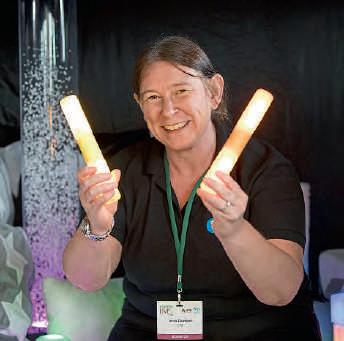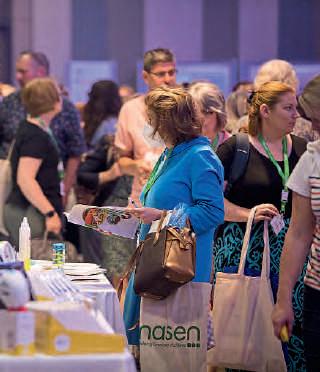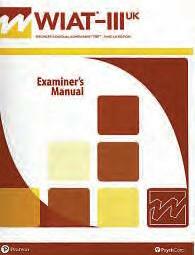








Asschoolsandsettingsheadedofffor asummerbreak, itwaswiththeanticipationof anewPrimeMinisterforthe startoftheacademicyearwhileunexpectedlywealso welcomed anewMonarch.
OurnewPrimeMinister,quotedinonespeechas‘theprimeministerfor education’,hasappointed anewCabinetofMinisters;allchangeforthose workingwiththeDepartmentforEducation(DfE).WhilethenewMinisters willundoubtedlyinfluencefuturepriorities,thereiseveryindicationthatSEND remains apriority.Thisis acrucialtimeasDfEmovesforwardswithplansto improvetheSENDsysteminEngland.

Thismonth IvisitedNorthernIreland,meetingwiththeinspiringgroupofSEND leadersonthenasenNIAdvisoryGroup. We lookforwardtosharingpractice infutureeditionsofConnectfromacrossthedevolvednationsoftheUK.
Hearingfromnasenmembersisimportanttousbutwealsowanttoensure youreceivethelatestnews.Doremembertocheckinonhowyouhaveset yourmembershippreferences,indicatingyouwishtoreceivenasenandWhole SchoolSENDcommunicationssothatupdateswillarrivedirectlytoyourinbox.
Thanksmembers,foryourfeedbackaboutnasenConnect,thatyouwouldlike tobeabletosharetheonlinenewsmorewidely,benefittingyourcolleagues whohavenotregisteredasnasenmembers.
Iamdelightedtosay,youwillfindthiseditionofnasenConnectenablesyouto dothat. Younolongerhavetobe anasenmembertoreadtheonlineversionof themagazineenablingyourcolleaguestoaccessthearticlesyouwanttoshare.
Thisis afirstfornasenConnect,tobeavailabletoall.
Tel:
Published
nasenconnect@nasen.org.uk
Designed by: HeadlinesPartnership Publishing, 4MilnyardSquare, BakewellRoad, Orton Southgate, Peterborough,England,PE26GX Email: info@headlinespp.uk.com www.headlines.uk.com
Advertisingenquiries: nasen House Tel: 01827311500 Email: sales@nasen.org.uk
Editorialenquiries: nasen House Tel: 01827311500 Email: nasenconnect@nasen.org.uk ©nasen. Allrights reserved.
Nopartof this publicationmay becopiedor reproduced,stored in aretrievalsystemortransmitted
inanyformorbyanymeanselectronic, mechanical,photocopy, recordingor otherwisewithoutthepriorpermission of nasen.
While everycarehasbeentakenin thecompilationofthispublication, nasencannotaccept responsibility foranyinaccuraciesorchangessince compilation,or forconsequential lossarisingfromsuchchangesor inaccuracies,or forany otherloss, directorconsequential,arisingin connectionwithinformationinthis publication.Theviewshereinarenot
necessarilythoseoftheeditor ornasen. Acceptanceof advertisementsdoesnotimply recommendation by nasen.Notall photographsinnasendepictchildren withspecialeducationalneeds. Manyofthephotographsaretaken inintegratedclasses.nasen would liketothankallthosewhohave contributedphotographs.
RegisteredCharityNo.1007023 RegisteredCompany,limited by guarantee,No. 2674379 (EnglandandWales)
Hearing from nasenmembers isimportantto usbutwealso wanttoensure youreceivethe latestnews.
VictoriaAnnanoutlineshowtechniques sheusestosupportautisticchildren canbenefitmainstreampupils.
AlookattheGreatSchoolLibraries campaignandhowitcanhelpimprove thewellbeingofpupilswithSEND.
Howsupportingsecondary-agedpupils withSENDtoengagewithnewsand mediaisbecomingevermoreimportant.



RogerBroadbandoutlineshisreflections onengagementandthesupport thatshouldbeinplaceforschools, teachersandthewidercommunity.
EmilySmithshareswhytheSENDReview presentsanopportunitytoimproveprovision andoutcomesineducationandhealth.
AmandaPearsondiscusseshowequine therapycanhelpchildrenandyoung peoplewithSEND.

TrishaLeeexplainshowcreativityand riskplayanimportantroleineducation whenitcomestobuildingliteracyand communicationskillsforchildrenwithSEN.
BarryCarpenterOBEsummarises thewhole-school,ethos-based approachforwellbeing.

IntoFilmoutlineswhatpractitionersneed toknowaboutidentifyingfilmssuitableas educationaltoolsforpupilswithSEND.















Thismonthwe’dliketoopen byexpressingourgratitude foryouroverwhelming supportatnasenLive2022! Thisyear’sshowatThe Voxwasexceptionallywell received,andweappreciateyourglowing feedback. Youcanreadmoreaboutthe eventonpages 8and 9.Anddon’tforgetto savethedateof 7July2023inyourdiary fornasenLive2023.
Asweenterthenewterm,oneofnasen’s keyfocusesforthisyearwillbemember engagement. We knowthatbyworking togethermore,wecanachievemore,so keep alookoutforthoseopportunitiesto stay
uptodate,comment,orhaveyoursay aboutsectorandpolicynews.

We’llalsobemakingsurethatyou receivethenewsyouwanttohear about,sodon’tforgettologintoyour membershipareaon aregularbasisto makesurethatyouarereceivingthemost uptodatenewsandinformationfromus.
Aspartofourengagementwith members,andaschampion,friend,and protectorofmorethan65,000members, nasencarriedout aseriesoffocusgroups, surveysandworkshopstolistento,capture andmakesurethatthevoiceofthesector wasreflectedwithinourorganisational responsetotheSENDReviewwhichwas


publishedbackinMarchthisyear.
Althoughwerespondedtoall 22questions,wedistilledthepartsthat nasen –andourmembers –feltmost stronglyabout. Youcanfind asummaryof ourkeypointsandfocusedresponsesat https://nasen.org.uk/consultations
We’llbelookingatmoreresponses throughouttheyear,and wegreatlyvalue youropinions,soifthereisanything you’dliketotalkaboutorfeedback on,pleasedocontactusdirectlyat membership@nasen.org.uk
Have awonderfulstarttothenewterm! Teamnasen
Ihadtowriteandtell youhow inspiredI was by nasenLive.Thewholeday reallyopened my eyestothebenefitsof inclusion by design, notonly forthepupils, butalsoinenabling stafftosupportmorepupilswithoutaddingto workloads. Manyofmystaff feel overwhelmed by theincreasingnumberofstudentswith SENand feeltheymustprovidesomething personalisedandindividualised foreachstudent onthe register or withanEHCP.Asyoucan imagine,thisadds more worktoanalready extremely demandingrole. Overthesummer, I’llbelookingintohow to reframemystaff’s thinkingoninclusionbydesignandhowthis supportsall.I willbeaccessingsomemoreof those resourceson your websitetosupportthis. Thanksagain.
SENCO,primary,Hampshire

Iwasinterestedtoreadthatnasenissupporting thedigitalisationofEHCPsinthe Welcomefrom theCEOinthelastedition.As aspecialschool pastoraldeputyheadteacher,wehaveEHCPs fromninedifferentlocalauthoritiesandeach oneisin adifferentformat,length,andcontains differentwaysofpresentingtheinformation. Iwould heartilywelcome aset formatand abetterway ofincorporatingpupilvoice,andaneasierway toaccesspriorversions. Ihopethisisonepartof theSENreviewthatdoescometofruitionandthe soonerthebetter! Deputyheadteacher,Sunderland




Editor:Thankyou fortaking thetimeto giveusyourfeedbackandwe areso pleasedthatyouhavetakensomuch awayfromtheconference.Inclusionis necessaryforallpupils,notjustthose withSEND,anditis crucialtosee belongingasa keypartofwhyitisso necessary.Welookforwardtohearing theimpact of your changes,letus knowif youwould liketoshowcaseyourlearning hereinnasenConnectfor afuture issue.
Iwas reallyinterestedto readthepieceon puppetsin thelastissueof Connect.Many yearsago, Ihad ayoungpersonwhohad adiagnosisofautism,andhe used ahand puppet totalkthroughashehadimmense socialanxietyaroundspeakingand was mutewithoutit.It wasinterestingto think abouthowittransformsfroma lifeless objectinto itsowncharacter andthat,I expect,ishow my youngpersonwasable tointeractwithpeersandstaff through this medium.Heovercamehisdifficultiesand wentontobecomeaveryvocal youngman, withmanytalents. Retiredteacher,York



Editor:Atnasen we recogni additionalworkloadaround withtheneedsandprocess peoplewithSEN,asourfind SENCO Workforcesurveysh (https://bit.ly/3AIJbCM).Any wayof reducingthisburden tobecelebrated, andwear withinterested partiestoen parent/carerandprofession giventheopportunitytofull childoryoung personwho i heartoftheprocess.

th the d deealiling ng ses es f foor y young ng dings gs i innthe e owewed d y po posisitive ve n issomomethihing ng ewororking nsurure th that at p pupupilil, nallvoice e ar are y r reflelect ct t the isat th the e
andself-esteem.Thankyoufor sesharing.
Editor: That is aninterest s ingst s ory,it’s goodtohearhow thiscouldsupport youngpeoplewhoaregiven thepuppet tocreate acharact c er andhow this,in turn,can develop theirownconfidence dself-este .Thankyou fo haring.



nasenlive 2022 washostedon


twasgreattosee somany ofyouatnasenLive2022. We weretrulyhonouredto havesharedthe daywith youandyourattendance andcontributionhelpedus, yet again, deliveratrulyunmissableevent for theSENDandeducationsector.

Theliveeventgenerated agreat buzz, enablingthesectortocometogetherto exchangeideas,insight,andexperiences.


Theone-dayeventwasformally opened by nasen’sCEO,Annamarie Hassall,andWillQuinceMP(Minister for Children andFamilies).


Theevent’s programmefeaturedkey figuresfromtheSENDsectordelivering awiderange ofseminars andkeynotes throughoutthe day.Delegateswere also giventhe opportunitytonetworkand explorethe latestdevelopmentsinthe


SEND andeducationsectorwithover60 leading,award-winningorganisations.







Theengagementduringthedaybetween delegatesandexhibitorswascleartosee, withnewrelationshipsforgedatevery opportunity,for thebenefitofall.











We arenow workinghardtoanalyse allfeedbackfromtheevent,sothat we canusethe informationtodevelopthe programme fornextyear, ensuringthat nasenLive2023offersall delegatesthe information, advice,and guidance they needto helpallyoungpeople.





Withthe nasen Awards2022ceremony lessthan twomonthsaway, takingplace on 14 October at theGrandHotel, Birmingham, we revisitsomeofthe winnersfrom last year’s awards. The nasen Awards areanopportunitytochampion,connectwith,and supportthoseworkingwith,andfor,childrenand young peoplewith SEND andlearningdifferences.





BramfieldHouseSchoolwontheaward foritsworksupportingexceptionallearning andoutcomesforyoungpeoplewith social,emotionalandmentalhealthneeds (SEMH).Partofitsremitas aspecialistSEMH schoolissupportingboysfromdisadvantaged backgroundsfromSuffolkandNorfolk.Over thepasttwoyears,staffatBramfieldhave strivedtodevelop anew,holisticcurriculum, leadingtothebestGCSEresultsinthe school’shistory, withoutcomeshigherthan thoseinmainstreamsettings.
HeadteacherDavinaBell,spokeofthe school’sdelight:“TheteamatBramfieldHouse Schooliselatedatwinningthisamazing award. We haveprovenyetagainthatSEN isnot adisadvantageandthat,withtheright
supportandcare,allyoungpeoplecanriseup andsucceedwithoutlimits.”
BramfieldHouseSchoolworkscloselywithits community,localschoolsandsurroundingspecial schools,tohelpstudentsfeel astrongsenseof communityandresponsibility.Theschoolhas workedhardtobuildanawarenessofenvironmental issuesamongitsstudents,andis aimingto become an eco-school,withpupilstaughtabouttheirimpact ontheenvironment,andlearningaboutthe world aroundthem.
Additionally,anew autismspectrumprovisionfor boyswhostrugglewiththedemandsofthesensory environmentmeansthatBramfieldHousestudents cannowmovefromoneareatotheotherwithout disruptiontotheireducationandcanlearnwith therapeuticpractitionerswithintheirownenvironment.


Oswestry’sDerwenCollegewonits nasen Awardforgoingaboveand beyondtosupportresidentialand daystudentswith awiderangeof complex needs,disabilities,andautism duringthepandemic,ensuringthat everystudent wasmotivated, engaged andlearning,whetherat home or

TheGrovepastoralteamwas recognisedfor supporting youngpeople with autism by developing andfosteringproductivepartnershipsin workingwithparentsandcarers –andultimatelyachieving100percent engagement with families.


Haringeyisan extremelydiverseLondonboroughwith avast multiculturalprofile, highlevelsof socialdeprivation,and alargenumber of familiesforwhomEnglish is their secondlanguage.Bysettingup afamily supportservicewhichfocusedoncommunication, andestablishingpositive relationships, staffcouldensure betteraccesstoservices forchildren, offeringbespoke trainingandservicestailoredtoeach family’s need.
in college. Embracingonline tools,staffensured everyone stayedconnectedwithsports day, prom,graduation, weekly sports challenges, national skillscompetitions, Makaton sessions,and even apetshow, allgoingaheadvirtually.
Forthosestudentswho remainedonsiteatDerwen College, workplacementsatthe college’svocationalpathways were totally reimagined.Students openedatakeaway food service,providinghospitality andfoodworkexperience. Thecollege evenconverteda classroominto acharityshop duringlockdown,whichhasnow openedtothepublic, providing work experienceinmarketing, displayandcustomerservice, alongsideraisingvital fundsfor theDerwenCollegeCharity. Elsewhere,theDukeof Edinburgh’sAward programme wentahead,with alarge woodlandareaadaptedto becomea dedicatedDukeof
Edinburghsitewherestudents couldsafelypractise their expeditionskills.Whenrestrictions were lifted, expeditions proceeded,with65students going onto receivebronze, silverandgoldcertificates. DerwenCollegeprincipaland CEOMerylGreen expressed thecollege’spride at receiving theaward.“Weare overthe moontohavewonsucha prestigiousnationalaward. Acrosstheboard,staffshowed imaginationand acommitment todeliverlearning,care,work experienceand supportto students –some in college,and someathome –throughthe pandemic.Thank youtonasen forhighlightingthe passionand commitmentofour inspirational DerwenCollegeteam.”
Since2018,TheGrove’sdedicatedpastoralteam,ledbyNadine Huseyin,hasprovidedongoingaccessfor families,respondingflexibly whenthetime isrightforthem,rather than whenit is convenientforthe team. Duringthepandemic,theymaintainedcontact with everyfamilyon aweeklyordailybasis,ensuringfoodandotherresourceswereprovided whereneeded.

Parentsandcarers attendedtrainingwiththeteam andsubmitted evidenceviaweekly photosandvideostohelptrackprogress.As aresult, therewerealmostnodipsinacademicprogressfor autisticpupils,and highlevelsoftrustweresecured.



SpeakingofTheGrove’s recognition,NadineHuseyin,familysupport andsafeguardinglead, said:“Manyofourpupilshavenot hada positive startineducation,andwehopetochangethat.Weworkcloselywith familiesto ensurethesupport weoffermeetstheirneeds. We aresoproud of ourteamandourschool. Morethanever,weareproudtoworkina communitywherechildren,youngpeopleandtheirfamilies wantto work withusandmakea difference inspecial education.”































TheDepartmentforEducation published updated suspension andpermanent exclusion guidancefor schoolsinJuly, following theconsultationearlierthis year. Theguidanceisdesigned to enableall pupils to learn and thrive in calm, safe andsupportiveenvironments.Ithas also been updated to reflect changes inlegislationgoverningthedisciplinary school suspensionand permanent exclusionprocesses.The document statesthat“permanentexclusionswill sometimesbenecessary as alast resorttomaintainthisenvironment”.
Part four of the guidance contains a section on special educational needs Keypointsinclude:
Under the Childrenand Families Act 2014,governing boardsof relevant settingsmustusetheir‘bestendeavours’ toensurethe appropriatespecial educational provision ismade for pupils withSEN, whichwillincludeany support in relation to behaviour management that they need because of their SEN Schools should engage proactively with parentsinsupportingthebehaviourof pupilswithadditionalneeds
Where aschoolhas concernsabout thebehaviour,orriskof suspension andpermanent exclusionof apupil withSEN,adisabilityoranEHCplan itshould –inpartnershipwithothers including,whererelevant,thelocal authority –considerwhatadditional

supportoralternativeplacement may berequired Thisshould involve assessingthesuitabilityofprovision for apupil’s SENordisability
Wherea pupil hasanEHC plan, schools shouldcontactthelocalauthority about any behavioural concerns at an earlystageandconsider requesting an early annual review prior to making thedecisiontosuspendorpermanently exclude. Forthosewith SEN butwithout
anEHCplan,theschoolshould review–with external specialistsasappropriate –whetherthecurrentsupport arrangementsareappropriateandwhat changes may be required.Thismay provideapoint forschools to request an EHC assessment or a review of the pupil’s currentpackageofsupport.
To accessth t e fullguidance,visit: https://bit.ly/3PGbKFs

Institute of Health Visiting (iHV), working together with Solent NHS Trust, has shared a short film to highlight the value and breadth of the role of the health visitor in relation to family mental health and wellbeing outcomes Produced as part of the Interreg 2Seas PATH project, the film raises the profile of the universal UK health visiting programme, where every family has access to a highly skilled and well trained health visitor It showcases the unique opportunity and skills that health visitors have in order to build relationships, and the support that health visitors can offer where additional concerns about parental mental health or the parent infant relationship are identified

To viewth t evideo,visit: https://t.co/VefS8oJPCA
The Making OurselvesHeard Forum encouragessupportivenetworks withinandbetween localareas, as wellasatthenationallevel.In additiontodevelopingthese networks,the forum allows youto accessthe fantasticopportunities shared(including events, engagement opportunities for childrenand youngpeople, recruitment)andshareyour own contentandprojects!
Frontlinepractitioners who engage directlywithdisabled childrenand youngpeople Those in rolessupporting strategicdecisionmaking,such asservicemanagers Thosewhocommissionservices Staffwhoaredevelopingjoint working Academics researchingand developingparticipation practices.
To signup,visit: https://bit.ly/3zdB9PL andselect registerfortheforum;a member ofstaffwillthenapprove you.

In July,The WorkFoundationpublished‘The Changing Workplace:EnablingDisability-Inclusive Hybrid Working’reportwhich highlightsthe benefitsthatthiswayofworkingcanprovide forstaffandtheiremployers.FundedbytheCity Bridge Trust,thereportsetouttoinvestigatewhether theexperiencesofremoteandhybridworkinghad supportedorhinderedthosewith adisability. The reporthighlightstheviewsfrom asurveyofover 400disabledpeople,interviewswith20disabled workersandtworoundtableswithemployersand otherstakeholdersabouttheirexperiences.
Themajorityofdisabled workerswhotookpart inthisproject valuedtheopportunitytodecide wheretheyworked,andthishadpositiveimpacts forthemandtheirorganisation
70percentofdisabled workerssaidthatiftheir employerdidnotallowthemtowork remotely, it wouldnegativelyimpacttheirphysicalor mentalhealth
Survey respondentsandintervieweeshighlighted clearbenefitsto workingfromhome,including havingmoreautonomyandcontrol over whenand howtheywork,whichinturnallowedthemtobetter managetheirhealthand wellbeing
Thisbroughtwiderbenefits fortheirorganisationstoo –85percentofdisabled workerssurveyed feltmore productiveworkingfromhome.

Despitetheshifttoremoteworkingbeingwell established,somewerestilllackingthesupportthatis essentialtodotheirjobathome.
Ofallsurvey respondentswho requestedadditional supportornewadjustmentswhile working remotely, closeto 1in5 (19.1percent)hadtheir request refused, withnoalternativearrangementsputinplace

Whilemostsurvey respondents(89percent) reportedtheyhadaccesstospecialistequipmentor softwareathome,intervieweesoften reportedthat they hadpurchasedequipmentthemselves,using their ownmoney
Just48ofthe406disabled workersthat were surveyed saidthattheyhadused the Government’sAccess to Work schemetofundsupport,withmorethan two-thirds(70.8percent)statingthatthishadbeena positiveexperience,andnearlyoneinthree(29.2per cent)sayingthishadbeen anegativeexperience.
Thereportcontainsrecommendationstogovernment andpracticalsuggestionsforemployersondeveloping inclusiveremoteandhybridworkingfordisabledworkers.
TheDownSyndromeAssociationhascreatedresourcesinresponsetothemanyqueriestheycontinue toreceivefromfamilieswhoremainunsureofexactlywhattheActdoes,andhowitcanbeapplied tosupportpeoplewithDown’sSyndrome.Theresourcesinclude asetofFAQs,aneasy-readversion, legaladvicefrombarristerSteveBroach,andvideoclipsfromSteveandIPSEAtakenfrom arecent eventfocusedonthelegalimplicationsoftheAct.
To accessthe resources,visit: https://bit.ly/3S3FEVU (Theconsultationclosesat11.45pmon 8November2022)

Anew research project organisedthroughthe Selective MutismInformation &Research Association(SMIRA),with fundingfromthe Communication Consortium GrantsProgramme, isinvestigatingthestatistics aroundSituationalMutism(SM) withinUKsecondary schools. Thecurrent statisticsforSM are around 15 yearsoldand require updating.SMIRAisalsolooking attheprevalenceofSM amongst childrenwitha diagnosisofautism as,untilrecently, thesehavebeen mutuallyexclusive.
Ifyouareinterestedintaking
partinthe project, findout more here: https://bit.ly/3zbJtzN andcontactSMIRA through itscontactpage: www.selectivemutism.org.uk/contact/
Currently,littleattentionispaidtohowparentalconflictaffectsthelivesofchildren withSENDintheUK. ApracticalguidefromtheEarlyInterventionFoundation, publishedforlocalareashasbeendeveloped.Theguidewillimprove understandingofhowriskfactorsamongparentsofchildrenwithbehavioursthat challenge,canimpactonparentalconflictandinturn,onchildoutcomes.Italso covershowtoeffectivelyengageparents,whatevidence-basedsupportcanbe offered,andhowtoappropriatelyassessprogressforthesefamilies.
Theguidefocusesonchildrenwithneurodevelopmentaldifficultiesor diagnosedneurodevelopmentalconditionswhomanifestbehaviours that challenge.Researchsuggeststhatparentsofchildrenwithbehaviours thatchallengemightexperiencehigher levelsofparentalstress. Parental stress,inturn,isassociatedwithahigherriskofrelationshipdistressand conflict,whichcanaffectoutcomesforchildren.Thescale andimpact ofthisislikelytovaryforchildrenwithdifferentconditionsandwith differentlevelsofsupport.
An overviewofthe research evidenceofthe factorsthatcanincreasethe riskofparentalconflictamongparentsofchildrenwithbehavioursthat challenge,andtheimpactofparentalconflictonchildoutcomes
Adviceonhowresearch evidencecanbeputintopracticetoinform your localstrategy
Recommendationsonhowtoengageparentsofchildrenwithbehaviours thatchallenge
Asummary of evidence-basedhealthy relationshipandparentinginterventions thatcanbeusedwithparentsofchildrenwithbehavioursthatchallenge
Asummary ofmeasurementtoolsthatcanbeusedtomeasureparental conflict,parentalstressandco-parentingwithparentsofchildrenwith behavioursthatchallenge.
To accesstheguide goto: https://bit.ly/3POD5p5


VictoriaAnnan,leadofadditionally resourcedprovision(ARP) for autismatChalgrovePrimarySchool,talksabouthowtechniquesshe usestosupportautisticchildrencanbenefitallmainstreampupils.

Notwo childrenwithSEND hadthesame experience of learningthrough lockdown.
AtForestLodge, ChalgrovePrimary School’sadditionally resourcedprovisionforautisticchildren, somepupilswereinschool regularlyduring thepandemicwhileotherscontinuedtheir learningremotely.
All pupils weregivenaccessto arich curriculum,whichincluded reading, writing, mathematics,scienceandphysical developmentwhichwastailoredtomeet theneedsofdifferentpupils. We also supportedthechildrenwithkeylifeskills andself-care.Children’sinterestswere
incorporated into their learningwhere possibleandpupilscompletedfortnightly projectson atopicoftheirchoice.
Someofourpupils withSENDcontinued toaccesslearningwiththeirmainstream classremotelyandusedtechnologytowork collaborativelywiththeirpeers.
What wegleaned fromthe experience ofteachingthroughlockdownwasthat manyofthestrategies we putinplace tosupportlearning,independenceand wellbeingforchildrenwithSENDworked justaswellforhelpingallmainstream learnersprogress.
Therearethree keyareaswhereone technique, usingvisualaidsin andaround theclassroom,canbenefitallchildren includingthosewithSEND.
Childrenhavecomethroughseveral lockdowns,oftenwithlimitedinteractions andreducedopportunityforlifeexperiences.


As aresult, manyhavenotdevelopedthe vocabularytheyneedtoprogressandrequire extrahelpnowtheyarebackinschool.

We typicallyusesymbolsfromWidgit tosupportthevocabularydevelopmentof childrenwithSENDaswellasotherchildren acrosstheschool.Theyprovidesimplevisual promptsforpupilswhostruggletoprocess writtenorspokenwords.
Symbolsareincorporatedintovisual timetables,forexample,withimagesto representdifferentsubjects.Thiscanbe reassuringfor achildwithautismbutcan beequallyeffectiveif apupilstruggleswith


anxiety, asthechildrencanquicklyseewhat isbeingtaughtnextandwhentheywillbe havinglunchortaking alearningbreak.
Ourstaffuse handheldsymbolstoo,such as‘washyourhands’or‘finished’,whichare simplertodigestforchildrenwhomayfeel overloadedwhenattemptingtodecipher spokenorwritteninstructions.Thesesymbols areparticularlyimportantwhen achildis feelingdysregulated.
Thecombinationoftextandsymbolic imagerysupportsallchildrentoprocess informationandfeedbackfromtheirteacherin abusyclassroomenvironmentandthishelps thembetterengageinwhat’sgoingon.


Visualsymbols canhelp learners becomemoreindependent.We provide somechildrenwithsymbolic routinesto help themnavigate the school day withoutthesupportofan adult. So,for playtime,wemight create asymbolisedroutinefor ‘get yourcoat, putiton, standinline, goouttheclassroomdoor,goonto the playground’withmatching images andtext.Many childrenfind symbolisedroutinescomforting and usethemregularlyasaide memoires.

Symbolsappearonsignagearound theschooltoo,helpingallpupilsto gettowhere theyneedtobe.They cansupport childrentoindependently collect andreturnitemssuchas classroomorsportsequipmenttothe correctplace.




Another effectivewaywe’veused symbolsisonthe schoollunchmenu. Theycanbejustaseffectiveat helping non-verbal orminimallyverbal childrenmakemeal choices as they areforthose whoarenervous orshy aboutspeakingtoothers, preventing themfromfeelingisolated.

SUPPORTING EMOTIONALWELLBEING Symbolscanbe apowerfulwaytosupport theemotionalwellbeingofanychildby helpingthemtoexpresshowtheyarefeeling whentheyareunabletoverbaliseemotions.
Emotioncardswhichincludesymbolicfacial expressionshelpchildrenwhohavelimited vocabularytolettheirteacherknowiftheyare feelingsadorfrightened.Theysimplypointto theemotiontheyareexperiencing,andthe teachercanstepinquicklytohelp.

Unexpectedchangehasbecomea commonfeatureofschoollifeforallchildren overthepast twoyears.Anotherwaywehave addressedthisatChalgroveiswithSocial Stories, aconceptdevelopedbyautismexpert CarolGrayinthe1990s.
Theyusesimplelanguagetoexplaina socialevent,situation,oractivityandare typicallyintheformatof ashortstory, comic strip,book,orpostermakingthemeasyto sharewithchildren.Whileoftenusedinautism provision,wenowincorporatethemmore widelytosupportallchildrenthroughchanges like anewmemberofstaffor aclassmate movingschools.
Schoolswillstopatnothingtoidentifyand addresstheissuesaroundlearningrecovery. Atourschool,thevisualpromptsandsymbols weusetosupportpupilswithSENDalsohelp usensureeverychildgetsthebestpossible chancetoachievetheirfullpotential.


Mediaheadlineshave beenshining abright lightonhowlockdowns andrestrictionstolearning duringthepandemic impactedthemental healthandwellbeingof childrenwithspecialeducationalneeds anddisabilities(SEND).

Onesurveyofheadteachersrevealedthat pupilswithSENDcouldbe astaggering fivemonthsbehindotherchildrenintermsof theiremotionalwellbeingandmentalhealth. Thesefigureswillmakedifficultreading foranypractitionerworkingtoimprove outcomesforchildren.


However,arecentstudybased on interviewswithlibrarianshashighlighted someoftheeffectivewaysthattheschool libraryisbeingusedtosupportpupils’ pastoralaswellaslearningneeds.
APEACEFULPLACE TO BE Inthestudy,whichwas partofthe GreatSchoolLibrariescampaignrun byCILIP(the LibraryandInformation Association),CILIP’sSchoolLibraries Group andtheSchoolLibrary Association,students drew pictures oftheir ideallibraryspaces.
It wasinteresting tonotethat childrenoftensawtheperfect school library as apeaceful refuge,notonly aplace wheretheycouldfinda goodbooktoenjoy.
ALISON TARRANTAlisonisthechief executiveoftheSchool LibraryAssociation(SLA) andco-chairofthe GreatSchoolLibraries campaign.Formerlya schoollibrarian,shehas setuplibrariesinnew schoolsandheldvarious rolesineducation includingmiddle management,giftedand talentedco-ordinator andformtutor.
Schoolscandesigntheirlibraries aroundthe visionof acomfortablefront roomathome.Withtheinclusionof appropriate lighting, musicordistraction toys, it’s possibletocreate acalmingand safeplace wherechildrencancometo reducelevelsof anxietyandstress.
Asonelibrarianwhowas interviewed explained:“Iwouldsaythatone of mymainrolesistogivethepupils somewheresafetogo.”



Therelationshipbetweenpupilsandtheir schoollibrarianis often apositiveone andsomepupilsfeeltheycanapproach theirschool librarianwithdifficulties whichtheymayprefernottodiscusswith theirteachers or support staff.
It wasinteresting to notethat children often sawthe perfectschool libraryasapeaceful refuge,not onlyaplace wheretheycould finda goodbooktoenjoy.

“I amnotasintimidatingas amember ofstaff,”saidanother librarianwespoke to.“Youfindyourselftalkingtothe pupils andtheyinvesta lotmoreintoyouthan maybethey wouldnecessarily talktoa teacherabout.”
Givingtheschoollibrarianthe opportunitytoaccessadditionalspecial needsormentalhealthtrainingwillhelp themidentify when achildishaving emotionaldifficultiessotheycanofferhelp.


Manyschools runprogrammesandclubs which arebasedintheirlibraries.These canoftensupport pupils’emotionalhealth indifferentways.
Somelibrarieshavereadinggroupsto help younger or less ablestudents improve theirreading skills,orschemeswhere children takeontaskstohelpwiththe runningof thelibrary.

Otherlibrarieshostmoreinformalgroups such as artormusic clubssochildren getto knowtheschoollibrary as afamiliar space wheretheycanhavefunandmakefriends.
Onelibrarianhighlighted:“The reason werunlotsofdifferenttypes ofactivities andevents istomake surethatstudents whomightnotassociatereadingasa really positivethingwillstillassociatethe librarywith somethingreallypositive.”
ChildrenwithSENDcanoftenbenefitfrom havingeasyaccesstoresourcestohelpthem understandhowtheyarefeelingandmanage theiremotions.Forolderchildrenwhocan seekhelpindependently,thelibrarycanbea richsourceofsupport.
Carolineisschool librarianatan independentschool inSouthEastLondon andchairofthe CharteredInstituteof LibraryandInformation Professionals’School LibrariesGroup.She hasworkedforover20 yearsinbothprivate andstateschoolsandis apassionateadvocate fortheequalityof provisionthatschool librariesbring.


Onelibrariantalkedabouttheadvantagesof herschoollibrary’sself-servicesystemforbooks onmentalhealth,whichenabledchildren tocheckitemsinandoutofthelibrary themselves,withouthavingtogothrough thelibrarian.Anotherhighlightedthe importanceofprovidingself-helpresources suitableforchildrenwithdyslexiaorthose whomightstruggletoread.
Offeringchildrensimplewaystoaccess self-helpmaterials,withguaranteedanonymity, canreassurethemthattheywillnotbejudged, whilemaintainingthepriorityofsafeguarding.
Withpupilwellbeing agrowingconcernfor allschools, awell-designedlibrarycanoffer everychild asafeplacetocomeandenjoya book,findnewfriendshipsandinterestsand getthehelpandsupporttheyneed.
Read thefullreport, which includesbestpractice examplesfrom schools andoffersatoolkitfor creating aschool library whichsupportspupils’ wellbeing,here: https://bit.ly/3JyBwcz
Youcan find further informationon the GreatSchool Libraries campaign at: https://bit.ly/3BHcUwj
Thereis agrowingawarenessthatmanyadultsbenefitfrompractisingmindfulness anditshouldcomeasnosurprisethatitcanhelptheyoungergenerations.Thereport suggestedthatrunningmindfulnessgroupswithintheschoollibrarycanbe agreat waytointroducetheconcepttochildrenandyoungpeople.
Thelibraryisoftenquieterthanotherareasoftheschool,makingit agoodplaceto helpchildrenleavetheirworriesatthedoor,asone librariandescribed:“Iwouldjust setup amindfulnessstationandwe’vegotactivitiesandpuzzles,anythingjusttocalm theirmind.Andwe’vegotbreathingtechniquesandgroundingtechniquesavailable forthemtodo.”


Whatschoolsneededwerredistinct resources,guidance anda trainingofferforteachersandstudents.TheDCMS OnlineMediaStrategy(2021)recognisedstudents with SENDmayhavelimitedaccesstomedialiteracy education.Its fundingenabledustoachieveouraim of developing aprogramme forteachers workingwith studentswithneedsthatincludegeneraland moderate learningdifficulties,andsocialandcommunication interactiondifficulties.
To beeffective, thecontent designshouldbeshaped by experts. We establisheda panelof 8teachersandan advisory teacher working withstudentsaged11-19witha rangeofreading levels, fromfoundationtoGCSE.Thiscoproduction, alongside medialiteracyspecialists,ensured extensiveinput,guidancceandevaluationfromtheteachers andtheirstudents,who testedtheresourcesastheywere adaptedandrevised
Threethemesarisingfromconsultationthatinformedand guidedthedevelopment of the resourceswere: flexiblecontenttosupportthewide variabilityof learnersand contexts accessible andengaging resourcesandmaterials detailed guidanceenablingteachersandteaching assistantsto tailorthecontenttotheirstudents’ specificlearningneeds.
Eight learning-age appropriate,crosscurricular activities andsupporting resourcescovering medialiteracyskills usingthecontext ofnews: What is news? Newsworthy stories Holdingpowerto account Spottingfake news

Targetednews online Factoropinion Balanced reporting Biasinnews reporting. Interactive‘fakeor forreal’workshop withsupporting materials
Acomprehensive teacherguide Medialiteracy teachertraining.
studentstomanyoftheconceptstheywillexploreinmore detailinthe activities,ina fun,interactive session.Using thissessionas aculminationofthesequencetoreinforce thelearningwouldalsoworkwell.
It’simportantto establisha safelearningenvironmentfor discussingnews.Thisincludes agreeingandreinforcing groundrules,such asrespecting others’opinions; balancingone-sidedstorieswithrelevant,reliable information; andusingdistancingtechniquessuchas charactersandscenarioswhensensitiveorcontroversial issuesare discussed.

We haveincludedscaffoldingsuchasglossaries, learningchecks andvisualprompts throughoutthe resources andweencourageteacherstoattendoneofour free trainingsessionstofindoutmore.
Oneteacherpanelmembersaid:“Pupilscommented onhowmuchtheyenjoyedtheinteractiveelementofthe resources.Theynavigatedtheresourcesindependentlyand theircommentsduringandafterthelessonindicatedthatthey understoodfundamentallearningpointssuchascheckingthe sourcesofstories,misinformationandfactandopinion.”

Activitieshaveinclusivelearningoutcomesusing amust/ should/could approach,whichallowsa rangeofoptions forlearningexperienceswithin agroup.Theactivities providea frameworkforallstudentstolearn and are designedtobeadaptedtomeetindividualneeds.They canbedeliveredasstandalonetasksintutor group sessionsortohoneinon aspecificskillortopicstudents wouldbenefitfrom.Alternatively, theycanbeused in sequencetobuild amoresubstantialunitoflearning.

The‘fakeorforreal’workshopisanexcellentway ofkickingoff thesequenceoflearning,asitintroduces

www.nasen.org.uk






























Thecurrentframeworkineducationhas

















Overthepasttwoyears(or more),supportagencies, schools,teachersand familieshaveworked admirablyunderless thanperfectconditions and,hopefully,efforts toimprovethesituationforchildren withSENDwillbringaboutsignificant improvement.Itshouldbe apriority forusall.Thepeoplewearetrying tosupportdidnotchoosetopresent themselveswiththeir uniqueness;itis ourresponsibility t toprovideaneducation systemfitforeveryone.Theburdenof responsibility t shouldnotsitonthe shouldersofthepupilsneeding theimprovedunderstanding;any newapproachmustfocuson adaptationsandpersoncentred support Deliveringthisisgoing tobetricky. We need tobebraveandclear

astothebenefitsto theindividualand broadercommunity t forgettingthisright. Theconsequencesfornotachievingthe desiredoutcome willbethe continuance ofthepresentscenarioforindividuals withSEND:highunemploymentrates; expensivelegalcostsincurred infighting foreducationalsupport;veryhighnumbers of offenderswith lowliteracy levels;and co-occurrenceofnegativementalhealth outcomes.Thisscenariocomesat ahuge costtothepersonandourcommunities.
Thiswillnotbe aquickwinforany government.Itisnuancedandrequires agreatdealofthoughtandapplication, aswellastheadequatefinancetoallow futuresuccessforallon alevel playing field.However,ifitisdonecorrectlythen we,theneurodiverse,thepeoplewhoare wired alittledifferently,yourfriendsand familymembers,andwidercommunity, willbeforeverintheirdebt.




HavingrecentlyvisitedtheHouseof Parliamenttointerview anumberof dyslexicMPsfromallparties,themood isoneofdeterminationtogetthings right.ItfeelsasthoughtheSENDgreen paperwillhaveuniversalsupport, especially if the funding matches theintent.Theview echoedby everyone Italkedtowasthatit is unacceptable that half of the prisonpopulationisdyslexic. Oureducationsystemneeds
Thereisnolinkbetweendyslexia andintelligence –weneedto empowertheyoungpersonsothat theycanreachtheirfullpotential.




tobemoreresilientinitseffortstoimprove basicliteracyandnumeracy.




ItwasinterestingtohearPeterKyleMP talk about his school experience When hewas13,hewasforcedtoreada passageofShakespearealoud.He was humiliatedashisteacherlaughedathis attempt.TheconsequenceforPeterwas thathemadethedecisiontogiveup onhislearningthereandthen.Itwas onlywhenhewentbacktostudyinhis mid-20sthathereceivedtherespect and supportheneeded.Hewentontogethis doctoratefromtheUniversity t ofSussex AnotherofthedyslexicMPsinterviewed, TomHuntMP, admittedthathecouldnot tiehisownshoelacesuntilhewas14, buthegot afirst-classdegreefromthe UniversityofManchesterand amaster’s fromOxfordUniversity.Thereisnolink betweendyslexiaandintelligence –we needtoempowertheyoungpersonso thattheycanreachtheirfullpotential.
Fortoolongparentshavenotfelt listenedto,andtheirfrustrationscan sometimesleadtoexpensivelegalcases. Inadditiontothefinancialcost,thetime lostduringtheseprotractedcasescosts schooltimeforthepupilconcerned. Thesearethekidsthatfalloutoflovewith educationand developthatnegativeselfstigmatisation –Ican’tdoit,I’m afailure!
Sowhere dowegofromhere,since wehavean excellentopportunity t to bring aboutpositive strategicchange?


It isessentialthatwehaveenoughqualified educationalpsychologiststoperform thenumbers ofassessments needed. Thesewillhelp buildthe long-term



BIO ROGER BROADBENT RogerBroadbentis adirectorofboththe DyslexiaInstituteUK andtheEmpowerment PassportLtd.Hisdyslexia wasnotdiagnoseduntil hewasinhis40s,and itspurredhimtobea passionateadvocate forfellowdyslexics, andotherpeoplewho areneuroatypical,or arefacedwithextra challengesaround mentalhealthand/or physicalhandicap. To getintouch,contact Roger@Empowerment Passport.co.uk or DyslexiaInstituteUK@ gmail.com andto findoutmore,visit empowerment passport.co.uk and dyslexiainstituteuk.com








strategybehindthe developmentofthe youngperson.Weneedtoembracethe technologythatisavailable, sothatthe extrachallengesthatcomewith dyslexia/ neurodiversity t arenotsoonerous Teachers mustbesupportedduringtheirtraining andinrole,andto learn aboutthe underlyingcomplexitiesof conditions.

Therearesomeforward-thinking teachertrainingdepartmentsatuniversities acrossthecountrythatareactively lookingtorecruitdyslexiccandidatesonto theircourses.Anexemplarofthisstrategy isProfessorJonathanGlazzardat Teacher TrainingDepartment,EdgeHillUniversity. Thisisoneofthepositivestepsthatwill notbeincludedintheSENDGreen Paper,yetitisjustthekindofinstitutional changethatweallneedtoembraceto deliverthecultureshiftneeded.

Thepeoplewearetryingtosupportdidnot choosetopresentthemselveswiththeir uniqueness;itisourresponsibilitytoprovide aneducationsystemfitforeveryone.

EmmaSmithoutlineswhy theSENDReviewpresentsa realopportunityto improveprovisionandoutcomesand whythisis relianton rectifyingthemisstepsofthepast.


The SEND GreenPaper acknowledgedtheChildren andFamiliesAct(CFA)


2014reforms hadtheright aspirations,but delivery hadfallen short.Whilst implementationfailingsare widelyaccepted,thefundamentalflawrelating tohealthprovisioninschools largelyremains unseen. Aclassic case of‘hiddeninplain sight’. Foranyhopeofimproved,integrated andconsistentservicesforchildren andyoung peoplewithSEND,itisimperativethatthisflaw isacknowledgedandaddressed.
Integrationis agoldenthreadthroughout thesystem-widereforms.Thiscontextis important,and thejigsawanalogyishelpful. Acomplete,joined-uppictureisbasedon threeprinciples:distinctpieces, defined boundaries andclearlinks.Similarly, these arethecharacteristicsofaneffectiveand navigableintegratedsystem. Viewinghealth andeducationintegrationthroughthislens illuminatestheproblemandsolution.
Healthisadistinctpieceinthejigsaw. In the caseofEastSussexCountyCouncilversusKS, Judge Ward highlightedtheimportanceofsector distinctions.“Thesystemsofspecial educational needs,careprovisionand healthprovisionare thesubjectofdifferingstatutory provisions,with differingduties imposed ondifferingbodiesand differinggovernancearrangements.”
AnNHS commissioningresponsibility should triggeranNHSpathwaywhichsits withinthe‘health’statutoryandgovernance framework. Araftoflegislationisassociated withthissuchasdutiesto deliveronquality andtheNHSConstitution.
NHSstatutory dutiesshouldbesufficient to secureNHSservicesinschools.Themeshing ofhealthand educationhasnotworkedbut analysisofwhat, whyand howbringsclarity.
Since 2013, localauthorities(LAs)inEngland havebeenresponsibleforpublichealth schoolnursingserviceswith theNHSretaining responsibilityfor servicestosupportadditional healthneeds,long-termconditions anddisabilities. LAs andNHScommissionersshouldhavejoint arrangementstofulfiltheir respectiveobligations. Despiteincreasingneeds,schoolleaders paint astark pictureofdecreasingand insufficientNHSinput, a‘postcodelottery’ of
provision,over-burdenedschoolstaff,highrisks, inappropriate useofhighneeds block(HNB) andlack of NHSaccountability.Thereisan expectation(and areality)thatschoolswillpick up‘health’activityeitheras health commissioners independentlysecuringservices,or asproviders, withschoolstaff deliveringhealthcare.
Crucially,thisactivitygenerallysits outsideNHScommissioning arrangements, circumventingtheNHSpathwayand the ‘health’ statutory andgovernanceframework. TheEHCP processillustratesthedivergence. TheCFA2014frameworkdictates that in thedraftEHCP,healthprovisionmustbe specifiedandshouldbeagreed, including whowillprovidetheintervention(s).These stepsprecede consultationandnaming aprospectiveschool.Therefore,itmakes nosensethata school,havingnoprior involvement,would thenbetheEHCP ‘health’provider.But thisiswhathappens.
Side-steppingtheNHSpathwayresultsin theepitomeof atwo-tiersystem;NHS-ledand education-ledhealthservices.TheNHSpathway gapcreatediswherethe‘health’issuesina SENDBermudaTriangle!
Delegationisthefaultline.Delegationinvolves registeredhealthprofessionalstransferring authorityto anindividual to perform atask. Unfortunately,asystem-widefailuretorecognise delegationhasledtosignificant missteps.The threekeypointsinthisareasfollows:
NHS ‘Quality’H ealth Services
CFA2014(Part 3ands.100)
StatutoryGuidance
NHScommissioning,fundingandcontracting


–NHSquality/constitution
–NHSgovernanceinc.clinicalgovernance

–NHSprovisionandoutcome data
–NHSincidentcaptureand learning
–‘Health’ECHPcompliance
–NHSaccountability
–NHSregulatory/inspectorateoversight
NHSPathway= NHS-led‘Quality’ HealthServices
ServiceDeliveryModel=
Statutory obligationsonhealthcommissioners donot existinavacuumbutwithin atangleof legislation,policyandpractice.Itislikelythat delegationcoupledwithaninter-playbetween these factorshascontributedtoimperceptible shifts in boundaries,givingthe appearance that the model‘fits’.Butevenwithinan integrated system,sectordistinctions remain,andstatutory schemesandpowersshouldnotbe stretchedto fillgaps.Arguably,the educationjigsawpiece hasbeenstretchedandskewed.
“The systems of special educational needs, care provision andhealthprovision arethe subject of differingstatutory provisions, with differingdutiesimposed on differingbodiesand differing governance arrangements.”
The factthat registeredhealthprofessional activitycanbe delegateddoesnotaffect atask’sclinicalnatureorremoveanNHS commissioning responsibilitywhereitexists. Thishas beenestablishedincaselawand is reflectedinNHSpolicy.
“Butthefactthatthe differingbodies are exhortedtocollaborate,inthe interestsof delivering amoreintegratedresulttothechildren andyoungpeople affected,doesnotmeanthat the underlyingstatutorydistinctions donotexist, northatthe powersofvariousbodies concerned canbestretchedsoastoyield ajoined-up solutionintheinterestsofthechildwheresuch asolutiondoesnototherwiseemerge.”Judge Ward,EastSussex CountyCouncilVKS(SEN)
tocooperatewithschools intheChildrenand Families Billwas omittedandcorresponding DfE guidanceoverlookstheconceptand implications ofdelegation. Consequently,NHS andregisteredhealthprofessionals’obligations areabsent, andNHS professionalinvolvement is presentedasoptional.
This meanswithinthe current delivery model,schoolsshouldbecommissionedto provideNHShealthcare. Acknowledgingsector distinctions,thereare twoquestions.Firstly,do schoolshavea legalobligation/powertobe NHSserviceproviders? Secondly,howwouldor could ‘health’governanceandqualitystandards beappliedwithineducation?
TheCFA 2014s.100welfaredutyonschools tomakearrangementstosupport pupils withmedicalconditionsisproblematicinits constructionandimplementation.AnNHSduty
Schoolsandstaffarepositionedas responsibleforhealthcareplans,‘training’ and provisionwithnoboundaries or limits,ineffecta catch-all.TheHaringey2005judgmentwarned thatabroadinterpretationofLAwelfareduties toincludemedicalprovisionwouldturnsocial servicesinto“a substitute oradditionalNHS for children”.Thereisnogreatleapfromthis descriptionandcurrenteducation-ledhealth services,particularlyinspecialistsettings.
Whiletrainingisan importantcomponent ofdelegation,theyare notinterchangeable terms.Healthprofessionaldelegation should alignwithprofessionalstandardsandguidance forriskassessment,training,competency, supervisionandincident management.
Butgiventhestatutory distinctions, areasonable interpretationof s.100wouldbethat schools leadsupportingpupils’healthneeds outside NHScommissioningresponsibilitiesandfacilitate accesstoNHS-commissionedservices.
AlthoughCFA2014 missteps areprobably themostsignificant,wider legislation, policy andpracticehaspotentiallyalsocontributedto incrementally shiftingboundaries.Forexample, Equality andHumanRightsCommission(EHRC) guidancereferstoschoolstaffproviding healthcareinterventionsas ‘reasonable adjustments’.In April2021,following communicationhighlightingissues,EHRC confirmedthe guidancerequiredclarifyingand updating. As yet,noupdatehasbeenissued.


TheGreenPaperfixesincludenational standards,clarifyingrolesandresponsibilities andstrengtheningaccountability, butthestarting pointmust bestatutorycompliance;theNHS pathwaygap must bereconciled. Inevitably, this will meanincreased NHSinvolvement which mayelicit warnings ofmedicalising schools.But ifchildrenandyoungpeople needhealthcaretoaccesstheireducation andthathealthcareisanNHS commissioning responsibility, thenitshouldbeanNHSquality service.A deliverymodelthatdowngrades healthcare,deniesthisbasicentitlement.
Ifthegenuineintentistodeliverimproved experiences,provisionandoutcomesfor children



Thefactthatthe differing bodiesare exhorted to collaborate, in theinterests of deliveringamore integratedresult tothechildrenand youngpeopleaffected,does not mean thattheunderlyingstatutory distinctions donotexist.





andyoung people with SEND,thentheway forwardmustbe to revisithowtheNHSmeets the health needsofchildrenandyoung people inschool.ArrangementsmustsecureNHS quality t servicesand putanendtoHNBsfunding ‘health’whichdivertsalreadystretchedresources awayfrom specialeducationalprovision.

Thenext stepscoverreviewinghealthand education asdistinctsectorpieces,defining boundariesandestablishinglinks.Theservice model mustbe consideredinterms ofdelegation andthestatutoryschemes toensurecompliance. AmendingtheCFA2014 s.100toincorporate anNHSdutytoworkwith schools would support this.CFA 2014guidance mustexplicitly definetheboundaries betweenNHS-ledand school-ledpathways.Finally,thepathwaysmust besecurelylinkedbyrobustjoint policiesand workingarrangements.























The goalofequineassisted therapy is tohelpchildren, adultsandfamilies to process andworkthrough theirfeelings,todevelop newwaysofthinking,to overcomeobstaclesandmoveforwards intheirlives.Thisspecialisedform of therapyinvolves workingincollaboration with ahorse andhighlytrainedtherapist. Sessionsprovide auniqueand powerful combinationofpsychotherapy,groundbasedexercisesandmindfulness.
Equinetherapycanbeaneffectivemethod ofhelpingpeoplestrugglingwithtrauma,
griefandloss,inparticularchildrenandadults withmentalhealthproblemsandchildren andyoungpeoplewithSENanddisabilities, includingautism,ADHDandbehavioural difficulties. To deliversessionsinourarea,we formedstrongpartnershipswithlocalstatutory agencies,schoolsandcommunityand voluntaryorganisationsincludingTheLooked AfterandLeavingCare Team,CAMHS, Targeted YouthServices,EarlyHelpand Safeguarding TeamandProbationservices.
Nomattertheirbackgroundorexperience –clientsrespond tohorses.Theunique qualitiesofthehorsespeed up emotional breakthroughs.
Ashighlyintelligentherdandprey animals,horseshaveevolvedtobe responsivetoeach other’sneedsfortheir ownsurvival,andthe survivaloftheherd.
Theyarehighly attunedandoffer clients safe reflectionandcompellingfeedback whencombinedwitha skilledfacilitator, helpingclients understandtheirowninternal processes more readily than hours of talk. Equinetherapy alsoofferstheopportunity tospendtimewithhorsesin afunand light-heartedwayifneeded.Thereisno pressure,no ‘right’or‘wrong’andno previousexperienceisrequired.
Studieshaveidentifiedthatchildrenwith autismengagingintherapeutichorseriding receivebothimmediate andlong-term benefits.Evidenceshowsthat directcontact withhorseshasmanylastingbenefits,and weexpect childrenwillshowimprovement inself-esteem andconfidence,reduced irritability,reducedhyperactivity,improved socialskills andimprovedword fluency.
Researchalsoindicatesthatthequality ofsocialnetworks, within andbetween

Amandaisthecentre managerandcodirectoroftheRed HorseFoundation. Amandaspentmany yearsworkingin healthandeducation organisationsandshe nowmanagesthe day-to-dayrunning ofthefoundation, supportingallclients, staffandhorseswiththe dailyroutine.TheRed HorseFoundationisa non-profitorganisation with ateamofmental healthprofessionals, supportingpeopleofall walksoflife,struggling withmentalhealth issues,inGloucestershire andbeyond.
outmore,visit
communities,ispositivelyrelated totheoverallwell-beingof marginalisedyoungpeople. Social networks facilitate emotionalsupport andreduce feelingsofisolationand depression.Our ‘Horsing Around’groups forautistic childrenandtheir primary carerencouragesocial inclusion, improveempathyskillsandprovide toolsto aidemotionalresilience.
In 2019,inthe firstlarge-scale, randomisedstudyofitskind,researchers at theUniversityofColoradoAnschutz MedicalCampusfoundthattherapeutic horseriding ledtoalastingreductionin irritability amongchildren with autism, alongwithother positivesocialand communicationimpacts.The study’s principalinvestigatorandleadauthor RobinGabriels,PsyD, professor of psychiatryatthe University ofColorado Schoolof Medicinesaid:“Thereisgrowing evidencethathuman-animalinterventions can improveemotionalhealthandsocial wellnessin youth, particularlythosewith autismspectrum disorder. Ourstudywas rigorousandthefindingsremarkable.”

Thestudywasthefirst to showthat taking partinequine-assistedtherapy resulted insignificantimprovementsinirritability, hyperactivity,socialskills,and word fluency comparedto abarnactivitycontrolgroupthat metat aridingcentretolearnabouthorses, buthadnodirect interactionwiththem.
Meanwhile,researchpublishedbythe UniversityofEdinburghin2018foundthat thosetakingpart inequine-assistedtherapy feltthathorses‘openup’autistic children
andmadepossibleinteractionsthat seemedimpossiblebefore.Respondentsin thestudy regardedhorsesas facilitatingthe emergenceofsocialbehaviours,including eyecontact,pointing,andspeech.Inthe study, threekeyexplanationsemerged fortherapeuticsuccess:thesensorial, embodiedexperienceofridingthe horse; thespecificmovementsandrhythmsofthe horse;andthe‘personality’ofthehorse.
TheAutismSpectrumDisorderFoundation (ASDF)alsooutlinedthebenefitsofequineassistedtherapyfor childrenwithautism: “Ratherthanverbalcommunication,autistic childrenexperiencephysicalcommunication withthehorses.Theybrushthem,hugthem, andpatthem.Bylearningtocarefor the horse,theyassociatethe caretheyprovide withfeelings andanemotionalbridgeis constructed.Thisbondcan leadtosocial andcommunicationskillproductionwith otherpeoplein[theirlives]aswell.”






















Creativity and risk can play important roles in education, especially when building literacy and communication skills for children with SEND, says Trisha Lee, founder of education charity, MakeBelieve Arts.







wrote five-year old Bella’s name at the top of my A5 sheet of paper Like many of the children I work with when I demonstrate for teachers, I had never met Bella before








“Are you ready to tell me your story?” I asked, aware of the group of teachers who were watching me
“W Pon A Tum,” said Bella
“I’m sorry? I didn’t quite hear you Could you repeat that?” I asked, moving my ear nearer to Bella’s mouth to make sure I didn’t miss anything When she repeated herself, I played the sounds silently around my head, unpicking the meaning Finally, it made sense


“Once upon a time?” I asked, checking with Bella that I had heard her correctly







She greeted my words with the biggest of smiles It was okay, I had understood her.


Theteachers behind me breathed
“A Prin Eh Live In A Car All,” Bella continued Her speech was difficult to understand, but once I had tuned my ear into the specific nuances of her language, I was confident I could scribe her story
This is one of the favourite parts of my work Taking a few minutes with a child

and listening carefullyto every word they say, so that I can writeit down verbatim Later the class willgatheraround a taped-outstageto actoutallof thestories that have been scribed thatday.Thisis Helicopter Storiesor Storytelling and Story Acting, based onthe work ofthelate Vivian GussinPaley and pioneeredinthe UK by education charity t ,MakeBelieve Arts Bella’s finished story went like this: “Onceupon atime, aprincesslivedina castle.Andwithreally longhair.With acape. Apinkcape.Hergot highheelson.Andher gotpinkhair.”

As IscribedBella’s story,Iwas making lots ofchoices.I couldhear she had speechand language difficulties,and she wasstruggling toshape the wordsin hermouth Whenthis












isthecase, I alwayswrite what Ibelieve the childis trying to tellme, ratherthan the words they actually say. If Ihadrepeated ‘W PonA Tum,’that would have feltlikeI was making funof Bella.By takingthetime toreallylisten to what shewassaying,I understoodthat it was onceupon a time When Ispoke these wordsout loud, Iacknowledged thatI understood her, and Bella’s confidencegrew

However, when itcame tothe grammar side of Bella’s story,I wrote her words verbatim

Byscribingverbatim, we create anexact record of achild’sgrammaticallanguage
This gives us a range ofevidence on where each childis with regards totheir speaking, narrative development and comprehension.Italso helps touncover thenatural rhythms unique to each child and we find out what’s important to th in their growth as storytellers.

If Ihad triedtochange Bella’sstory into amoregrammaticallycorrectversion,I would havechangedthetempoofher story.WhenBelladictatedtome,she saidherwordswithpride, lookingintothe distanceasifshecouldseetheprincess shewasdescribing.

em
Oneofthebestthings aboutHelicopter Stories isthattheprocessdoesn’tend with thestorybeingtold.Itisthenbroughttolife infrontofanaudience.WhenBella acted outherstory, Ireadeachphasebackto herexactlyasshesaidit.ThenI askedto seetheactions.
“CanI seetheprincesswalkingaround thestageinherhighheels?Shall we pretendthatyouhavepinkhair?”

Duringthisprocess,Bellademonstrated creativity. Shecreatedanimaginarycharacter andrevealedthedepthofhercomprehension throughherabilitytobringherstoryto life.Becauseherideaswerevaluedand heruniquewayofexpressingherselfwas accepted,herconfidencesoared.
HelicopterStoriesgives childrenthe spacetodeveloptheirimagination.The approachislinkedto themostimportant learningtoolwehave, fantasyplay,and itenablesusasadults, towitnessthat learningtoolinaction andto seethe impactthatplayhas onourchildren.
DuringHelicopterStories,childrenare allowedtogettheirstory out,to explore theircreativitywithoutinterference.They aregiven anopportunitytomakeupstories withoutplanningorfixingit first.Amazingly, whenweset up spacefor thistohappen, childrenembrace iteffortlesslyfromas youngas twoyearsofage.
Thereare manyskillsthatchildren incorporatewhentheydictateandact outtheirstories.Theyare spontaneous,

www.nasen.org.uk
they improvise,theycommunicatewithan audience,andcreatesomethingoutof nothing. To achievethis, theyuseall the meansattheirdisposal,the expressionson theirfaces,themovementoftheir hands, thewordsthey knowandtheonesthey inventto communicatemeaningtotheir friends.Theytelltheirstorieswith urgency, asit formsintheirminds.And,whenwe scribechildren’sstories andmaketimeto actthemout,weplace valueontheway they describetheiruniverse.
‘Hergothighheels. Andhergotpinkhair.’








Whenevaluatingthe outcomesoftheSMILE Project,we wantedto captureyourprocessof developingSMILE in your school,lookingat your originalemotionalhealth andwellbeingsupportsandstrategies, whatyou calledinto question,whatyou keptand what you adjustedorintroduced. Theevaluation questionissimple:Isthe SMILE whole school approacheffective in promotingpositivewaystoimprove wellbeingand mentalhealthinschool communities?But howisthisanswered?
Working with 10partnerschools,we optimisethe SMILEapproachfortheir context,evidencetheiruseofSMILEin adaptingtheirEHWBprovisionand practicesandcollatetheir findings and
evidencetostrengthentheevaluationof SMILE.Ourpartnerschools attendedSMILE projecttraining;providedactivemembership oftheStrategicBoard;collectedand sharedtheevidenceandfindingsethically andwithintheprojecttimeline;tookpartin disseminationactivities(e.g.end-of-project conference) andmadeearlycontact with theprojectlead(IsobelJerrard,Forest Oak School) in case of difficulties
There are several project roles that needed to be examined during evaluation The steering board’s role is advisory, providing and bringing additional perspectives Forest Oak/Merstone School’s role is one of overall evaluation, evidence collation


and reporting, while our partner schools’ roles are to implement the SMILE ethos; pilot mental health approaches and collect whole school evidence The pilot class's/ year group ' s role is to collect case study evidence, optimise interventions and feedback on effectiveness Finally, the role of all classes is one of implementation and class based evidence collection
The SMILE project has core inquiry Q&As, such as ‘where are we now?’ to audit policies, processes and interventions for staff and children; ‘where are we going?’ to identify a key EHWB focus for your school and each school’s unique EHWB best hoped for outcomes and, finally, ‘how are we getting there?’ which examines school improvement priorities When examining the planning and aims, we asked questions such as ‘how can we evidence it?’, along with briefing and agreeing the project scope and aims with our 10 partner schools We provided foundational training, obtained fully informed consent for case studies, and anonymised all data
Typesofevidenceusedto evaluatethe projectincluded interval; beginning(baseline)/ middle/endofprojectand audits such as EHWBquestionnaires (e.g.,WEMWBS,coping strategies);ongoingevidenceto chartdevelopment,suchasevent logsandcasestudies;andreflective evidenceattheend-of-phaseor end-ofproject, suchas evaluativequestionnaires.
To gatherthe information,we have partnerschoolcontributiontoevaluation to audit and analysethegaps,identify f possibleEHWBfocuses,the possible actionslinkedto SMILE, the‘besthoped-for outcomes’andtokeep anongoingevent logof organisation-levelinterventions.

Existing school dataanalyses identify f areas of EHWB concern for yourschool,the additional data evidence needed andthe ‘best hoped for outcomes’











































Film Films can inspire us, scare us, make us laugh and ma make us grimace, but how can they help us teach pu pupils with SEND, and which films are suitable to du too ational Lot
use as educational tools? The National Lotteryfundedcharity, IntoFilm, outlines whatpractitioners need to know,andspeakstotwoschools about their experiencesusing filminthecurriculum.
IntoFilmis afilmeducation charity t thatseekstogive everychildandyoung person aged5-19in the UK thechanceto experiencefilmcreatively.
Thecharity t ’s programme includestheIntoFilm+ streamingplatform, extra-curricularIntoFilm Clubs,resources foruseinclubsortheclassroom,faceto-faceandonlinetrainingopportunities, an annual cinema-basedfilmfestivaland the prestigious Into Film Awards The programmehasbeendesignedtomeet the needsofall fournations intheUK. Find out more about allthisat intofilm.org
IntoFilmaimsto supportteachersin achieving arange ofeffective learning outcomesintheir useof film,andchief amongstthosebeneficiariesareSEND educators.Themultisensory nature of film canbeincrediblyeffectivein levellingthe playingfieldforstudentswith SENDwho mightstrugglewith thetraditionalcurriculum, mostsignificantly whenstudyingtext. Filmmaking,filmreviewingand discussion withpeerscanalsoprovide acreativeoutlet and thechanceto thriveinsocialsituations.
We recommend thefollowing films, availableonInto Film+forstudents withSEND.Animationisparticularly













effective as both a practical activity and for communicating new ideas to learners with SEND of any age, which is why three of the titles are animated. We also house several relevant short films on Into Film+ that are between two and eight minutes, so are perfect for when there isn’t enough time to watch a full-length feature.
Two of the films – Home and A Monster Calls – include new film guides that have specifically been made for students with SEND with the input of experts.



Home – One of Into Film’s most popular and accessible titles, Home is a brightly coloured film that nevertheless does not overwhelm pupils with sensory issues. This film finds the lead character coming to understand that being different and making mistakes is part of being human.
The Polar Express – An animation that uses motion capture technology to tell a unique Christmas story. Into Film has put
on screenings with audiences with SEND before that love this film due to its distinctive style and narrative.
Spider-Man: Into the Spider-Verse –This film comes with instant character and franchise recognition. It is currently Into Film’s most popular secondary title on Into Film+.
A Monster Calls – This film focuses on a young person who is struggling to cope with his mother’s illness and being bullied in school. It highlights the importance of fantasy as escapism and does not talk down to its audience but rather invites them to share the protagonist’s feelings in an appropriate way.
Head to intofilm.org/SEND to discover more films and resources that we offer for pupils of all ages with SEND.
As a special school for autistic children, we welcome every opportunity to enrich our pupils’ educational journey and our children are passionate about learning through film.

With the support of Into Film, I have been running an Into Film Club over the last 12 years that includes all children in my school, from reception through to Year 6. Our film club is embedded in the curriculum and has helped our children access realworld opportunities that otherwise would have felt overwhelming. After winning £1,000 in a photographic competition, I purchased a DSLR camera and laptop for the school, and started teaching photography for my students, which led to animation and filmmaking.
Film’s impact all starts in reception where one student, for example, started saying a few words while animating. Building on these progression steps helps them prepare for their transition to feeder schools, which
have visited us for best practice and advice.
Every day brings something new to excite myself and the students, especially film reviews where they can share the unique things they see, such as characters in the background and their role in the film. Whereas you and I would probably only remember the main characters, they remember characters in the background and their specific roles - they blow me away!

Visiting the cinema is a huge barrier for many of our students so we created our own immersive cinema experience, screening films from the Into Film+ catalogue for pupils to access in a safe, accepting environment. Posters are presented the week before and students ‘buy’ their ticket using two pieces of work relating to the film. Afterwards, they create film reviews, storyboards and short animations. The positive feedback we have had from parents has been incredible, with many now able to enjoy regular visits to the cinema as a family.

We established our first Into Film Club 10 years ago, and the introduction of film to pupils with SEND has been a phenomenal success. Club members work collaboratively with pupils across the academic divide. This could include pupils who have literacy difficulties, those deemed ‘gifted and talented’, those whose first language is not English and many who have social, emotional and behavioural difficulties. Particularly throughout lockdowns, watching, discussing, reviewing and creating films provided a welcomed respite.
Many club members were at risk of becoming disengaged with school and socially excluded but being part of a film club has offered them the opportunity to interact socially. Pupils with SEND can often have low aspirations but incorporating film into teaching can give them a real sense of worth and a desire to achieve despite adversity. One GCSE class has pupils with ASD, Tourette’s syndrome and cognition/learning difficulties, but they still collaboratively assigned every person an individual role and created their own film.
Into Film+ has enabled us to use film as a teaching tool across all departments and curricular areas as well as ages and abilities. The wealth of films available has been incredibly useful, particularly the recent mental wellbeing programme.
Aside from Into Film+, we have also triumphed at the Into Film Awards and seen several film review competition winners. Most recently, one of our ASD pupils who just transferred to us from a special school was announced as a review winner and the joy she experienced will remain with me for a lifetime.

































